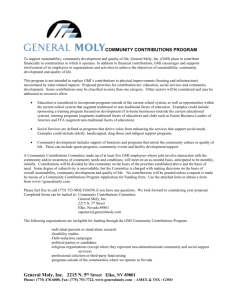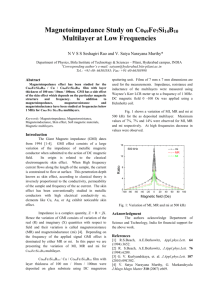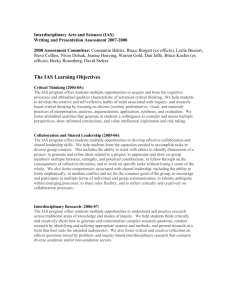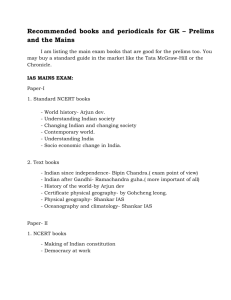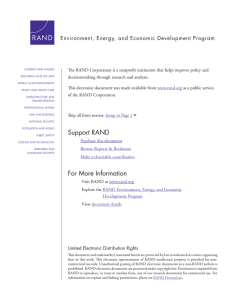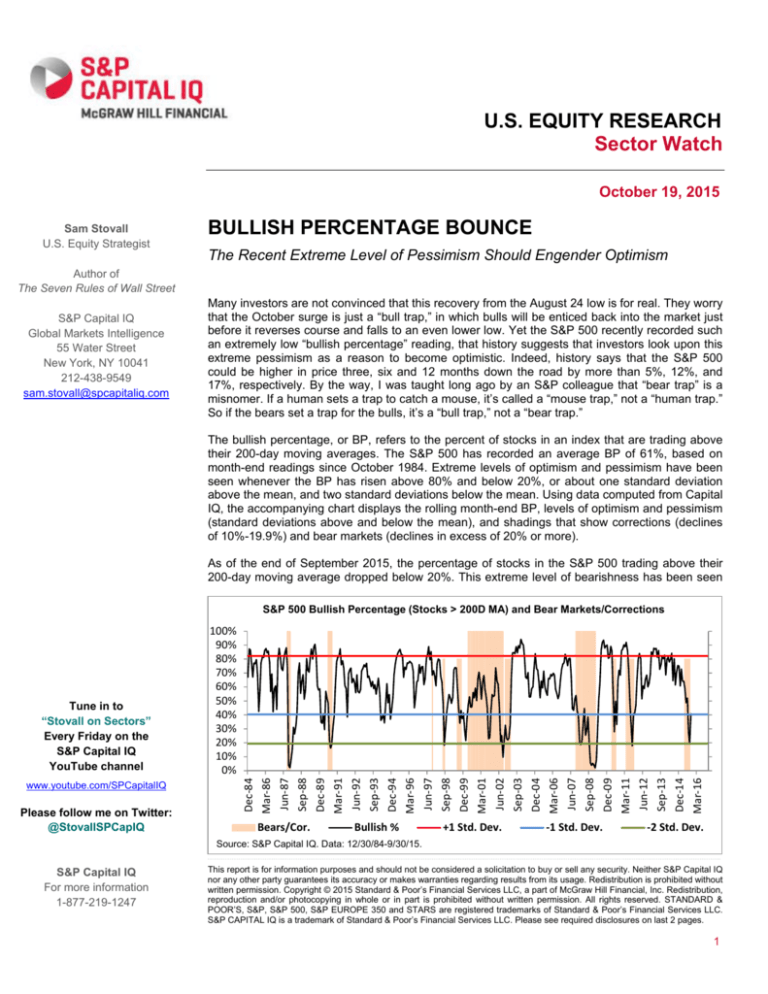
U.S. EQUITY RESEARCH
Sector Watch
October 19, 2015
Sam Stovall
U.S. Equity Strategist
BULLISH PERCENTAGE BOUNCE
The Recent Extreme Level of Pessimism Should Engender Optimism
Author of
The Seven Rules of Wall Street
S&P Capital IQ
Global Markets Intelligence
55 Water Street
New York, NY 10041
212-438-9549
sam.stovall@spcapitaliq.com
Many investors are not convinced that this recovery from the August 24 low is for real. They worry
that the October surge is just a “bull trap,” in which bulls will be enticed back into the market just
before it reverses course and falls to an even lower low. Yet the S&P 500 recently recorded such
an extremely low “bullish percentage” reading, that history suggests that investors look upon this
extreme pessimism as a reason to become optimistic. Indeed, history says that the S&P 500
could be higher in price three, six and 12 months down the road by more than 5%, 12%, and
17%, respectively. By the way, I was taught long ago by an S&P colleague that “bear trap” is a
misnomer. If a human sets a trap to catch a mouse, it’s called a “mouse trap,” not a “human trap.”
So if the bears set a trap for the bulls, it’s a “bull trap,” not a “bear trap.”
The bullish percentage, or BP, refers to the percent of stocks in an index that are trading above
their 200-day moving averages. The S&P 500 has recorded an average BP of 61%, based on
month-end readings since October 1984. Extreme levels of optimism and pessimism have been
seen whenever the BP has risen above 80% and below 20%, or about one standard deviation
above the mean, and two standard deviations below the mean. Using data computed from Capital
IQ, the accompanying chart displays the rolling month-end BP, levels of optimism and pessimism
(standard deviations above and below the mean), and shadings that show corrections (declines
of 10%-19.9%) and bear markets (declines in excess of 20% or more).
As of the end of September 2015, the percentage of stocks in the S&P 500 trading above their
200-day moving average dropped below 20%. This extreme level of bearishness has been seen
S&P 500 Bullish Percentage (Stocks > 200D MA) and Bear Markets/Corrections
Bears/Cor.
Bullish %
‐1 Std. Dev.
Dec‐14
Mar‐16
Sep‐13
Jun‐12
Mar‐11
Sep‐08
Dec‐09
Jun‐07
Mar‐06
Dec‐04
Jun‐02
+1 Std. Dev.
Sep‐03
Dec‐99
Mar‐01
Sep‐98
Jun‐97
Mar‐96
Sep‐93
Dec‐94
Jun‐92
Mar‐91
Dec‐89
Jun‐87
Sep‐88
Please follow me on Twitter:
@StovallSPCapIQ
Dec‐84
www.youtube.com/SPCapitalIQ
Mar‐86
Tune in to
“Stovall on Sectors”
Every Friday on the
S&P Capital IQ
YouTube channel
100%
90%
80%
70%
60%
50%
40%
30%
20%
10%
0%
‐2 Std. Dev.
Source: S&P Capital IQ. Data: 12/30/84-9/30/15.
S&P Capital IQ
For more information
1-877-219-1247
This report is for information purposes and should not be considered a solicitation to buy or sell any security. Neither S&P Capital IQ
nor any other party guarantees its accuracy or makes warranties regarding results from its usage. Redistribution is prohibited without
written permission. Copyright © 2015 Standard & Poor’s Financial Services LLC, a part of McGraw Hill Financial, Inc. Redistribution,
reproduction and/or photocopying in whole or in part is prohibited without written permission. All rights reserved. STANDARD &
POOR’S, S&P, S&P 500, S&P EUROPE 350 and STARS are registered trademarks of Standard & Poor’s Financial Services LLC.
S&P CAPITAL IQ is a trademark of Standard & Poor’s Financial Services LLC. Please see required disclosures on last 2 pages.
1
in only six other
periods since 1984 –
the bear markets of
1987, 1990, 2000-02,
and 2007-09, as well
as the corrections of
1998 and 2011. The
average price change
in
the
subsequent
three, six, and 12
months were gains of
5.5%,
12.5%,
and
17.4%,
respectively.
What’s
more,
the
frequency with which
the S&P 500 rose in
price
in
those
subsequent periods were 82%, 82%, and 88%. In 1987, there were four months in a row in which
the BP was below 20%. In all subsequent time periods (3, 6 & 12 months), the S&P 500’s percent
changes were positive. In 1990, there were two months in succession with BPs below 20%. In
both times, the market was also up three, six, and 12 months later. Ditto for the single month-end
readings in August 1998, September 2002, and September 2011. Only during the bear market of
2007-09 did a BP below 20% offer premature bullish signals. However, the average 3, 6 & 12
month returns following these multiple signals were +0.9%, +9.2% and 11.8%.
So there you have it. History says, but does not guarantee, that due to the extreme level of
bearishness recently exhibited by the bullish percentage, the equity market’s dials have likely
been reset and that stock prices should continue their ascent in the three, six, and 12 months
ahead. Only if the correction of 2015 morphs into a new bear market rivaling that of 2007-09 (an
eventuality that S&P Capital IQ does not anticipate) should we worry about having received a
premature “all clear” signal.
S&P Capital IQ
For more information
1-877-219-1247
SECTOR WATCH
2
Required Disclosures
Glossary
STARS Raking system and definition:
★★★★★ 5-STARS (Strong Buy):
Total return is expected to outperform the total return of a relevant
benchmark, by a wide margin over the coming 12 months, with shares
rising in price on an absolute basis.
★★★★☆ 4-STARS (Buy):
Total return is expected to outperform the total return of a relevant
benchmark over the coming 12 months, with shares rising in price on an
absolute basis.
★★★☆☆ 3-STARS (Hold):
Total return is expected to closely approximate the total return of a relevant
benchmark over the coming 12 months, with shares generally rising in price
on an absolute basis.
★★☆☆☆ 2-STARS (Sell):
Total return is expected to underperform the total return of a relevant
benchmark over the coming 12 months, and the share price not anticipated
to show a gain.
★☆☆☆☆ 1-STAR (Strong Sell):
Total return is expected to underperform the total return of a relevant
benchmark by a wide margin over the coming 12 months, with shares
falling in price on an absolute basis.
S&P Capital Ranking Definitions:
Overweight rankings are assigned to approximately the top quartile of the
asset class.
Marketweight rankings are assigned to approximately the second and third
quartiles of the asset class.
Underweight rankings are assigned to approximately the bottom quartile of
the asset class.
S&P Capital IQ Quality Ranking
Growth and stability of earnings and dividends are deemed key elements in
establishing S&P Capital IQ's earnings and dividend rankings for common
stocks, which are designed to capsulize the nature of this record in a single
symbol. It should be noted, however, that the process also takes into
consideration certain adjustments and modifications deemed desirable in
establishing such rankings. The final score for each stock is measured
against a scoring matrix determined by analysis of the scores of a large and
representative sample of stocks. The range of scores in the array of this
sample has been aligned with the following ladder of ranking.
A+ Highest
A
High
A- Above Average
B+ Average
B
BC
D
Below Average
Lower
Lowest
In Reorganization
Required Disclosures
Global Markets Intelligence (“GMI”) is a business unit of S&P Capital IQ.
Standard & Poor’s Investment Advisory Services LLC (“SPIAS”) and
McGraw-Hill Financial Research Europe Limited (“MHFRE”)
(collectively, “GMI Investment Advisory Services” or “GMI IAS”), each a
wholly owned subsidiary of McGraw Hill Financial, Inc., operate under the
GMI brand. GMI IAS provides non-discretionary advisory services to
institutional clients and does not provide advice to underlying clients of the
firms to which it provides advisory services. In the United States, advisory
S&P Capital IQ
services are offered by SPIAS, which is authorized and regulated by the
U.S. Securities and Exchange Commission. SPIAS does not act as a
"fiduciary" or as an "investment manager", as defined under Employee
Retirement Income Security Act (ERISA), to any investor. MHFRE, is
authorized and regulated by the Financial Conduct Authority in the United
Kingdom. Under the Markets in Financial Instruments Directive (‘MiFID’),
MHFRE is entitled to exercise a passport right to provide cross border
investment advice to European Economic Area (‘EEA’) States. MHFRE has
duly notified the Financial Conduct Authority in the United Kingdom of its
intention to provide cross border investment advice in EEA States in
accordance with MiFID. MHFRE trades as S&P Capital IQ, does not
provide services to “retail clients” and only has “professional clients” as
defined under MiFID. In the United Kingdom to the extent the material is a
financial promotion it is issued and approved by MHFRE. In Hong Kong,
advisory services are offered by Standard & Poor's Investment Advisory
Services (HK) Limited (“SPIAS HK”), which is regulated by the Hong
Kong Securities and Futures Commission; in Singapore, by McGraw-Hill
Financial Singapore Pte. Limited ("MHFSPL"), which is regulated by the
Monetary Authority of Singapore; in Malaysia, by Standard & Poor's
Malaysia Sdn Bhd (“S&P Malaysia”), which is regulated by the Securities
Commission of Malaysia; and in Australia, by Standard & Poor's
Information Services (Australia) Pty Ltd ("SPIS"), which is regulated by the
Australian Securities & Investments Commission. In Korea, SPIAS holds a
cross-border non-discretionary investment adviser license and it is
registered with the Financial Supervisory Service (FSS). SPIAS, MHFRE,
SPIAS HK, MHFSPL, S&P Malaysia and SPIS, each a wholly owned
subsidiary of McGraw Hill Financial, Inc. operate under the GMI brand.
GMI IAS offers four broad categories of investment advice: (i) portfolio
strategies; (ii) fund research and recommendations; (iii) asset allocation;
and (iv) analyses of certain U.S. and European fixed income securities using
its proprietary Risk-to-Price scoring methodology. GMI IAS’ model
portfolios (“model(s)”) are not collective investment funds. Assets managed
in accordance with the models may lose money. GMI IAS is not responsible
for client suitability and or the appropriateness of the service for the client.
Any performance data quoted represents past performance. Past
performance is not indicative of future returns.
With respect to the investment recommendations made by GMI IAS,
investors should realize that such investment recommendations are provided
only as a general guideline. There is no agreement or understanding
whatsoever that GMI IAS will provide individualized advice to any
investor. GMI IAS is not responsible for client suitability. GMI IAS does
not take into account any information about any investor or any investor’s
assets when providing investment advice. GMI IAS does not have any
discretionary authority or control with respect to purchasing or selling
securities or making other investments. Individual investors should
ultimately rely on their own judgment and/or the judgment of a financial
advisor in making their investment decisions. Investments are subject to
investment risks including the possible loss of the principal amount
invested. An investment based upon GMI IAS’ investment advice should
only be made after consulting with a financial advisor and with an
understanding of the risks associated with any investment in securities,
including, but not limited to, market risk, currency risk, interest rate risk
and foreign investment risk.
SPIAS, MHFRE and its affiliates (collectively, S&P) and any third-party
providers, as well as their directors, officers, shareholders, employees or
agents (collectively S&P Parties) do not guarantee the accuracy,
completeness, timeliness or availability of the Content. S&P Parties are not
responsible for any errors or omissions (negligent or otherwise), regardless
of the cause, for the results obtained from the use of the Content, or for the
security or maintenance of any data input by the user. The Content is
3
Required Disclosures
provided on an “as is” basis. S&P PARTIES DISCLAIM ANY AND ALL
EXPRESS OR IMPLIED WARRANTIES, INCLUDING, BUT NOT
LIMITED TO, ANY WARRANTIES OF MERCHANTABILITY OR
FITNESS FOR A PARTICULAR PURPOSE OR USE, FREEDOM FROM
BUGS, SOFTWARE ERRORS OR DEFECTS, THAT THE CONTENT’S
FUNCTIONING WILL BE UNINTERRUPTED OR THAT THE
CONTENT WILL OPERATE WITH ANY SOFTWARE OR
HARDWARE CONFIGURATION. In no event shall S&P Parties be liable
to any party for any direct, indirect, incidental, exemplary, compensatory,
punitive, special or consequential damages, costs, expenses, legal fees, or
losses (including, without limitation, lost income or lost profits and
opportunity costs or losses caused by negligence) in connection with any
use of the Content even if advised of the possibility of such damages.
Based on a universe of funds provided to SPIAS, SPIAS may include in a
model portfolio or substitution list, if applicable, otherwise present as an
investment option and/or recommend for investment certain funds to which
S&P licenses certain intellectual property or otherwise has a financial
interest, including exchange-traded funds whose investment objective is to
substantially replicate the returns of a proprietary S&P Dow Jones Indices,
such as the S&P 500. SPIAS includes these funds in models, otherwise
presents them as an investment option and/or recommends them for
investment based on asset allocation, sector representation, liquidity and
other factors; however, SPIAS has a potential conflict of interest with
respect to the inclusion of these funds. In cases where S&P is paid fees that
are tied to the amount of assets that are invested in the fund or the volume
of trading activity in the fund, investment in the fund will generally result in
S&P receiving compensation in addition to the subscription fees or other
compensation for services rendered by SPIAS.
Poor’s Ratings Services may receive compensation for its ratings and
certain analyses, normally from issuers or underwriters of securities or from
obligors. S&P reserves the right to disseminate its opinions and analyses.
S&P's public ratings and analyses are made available on its Web sites,
www.standardandpoors.com (free of charge), and www.ratingsdirect.com
and www.globalcreditportal.com (subscription), and may be distributed
through other means, including via S&P publications and third-party
redistributors. Additional information about our ratings fees is available at:
www.standardandpoors.com/usratingsfees.
GMI IAS may consider research and other information from affiliates in
making its investment recommendations. The investment policies of certain
model portfolios specifically state that among the information GMI IAS
will consider in evaluating a security are the credit ratings assigned by
Standard & Poor’s Ratings Services. GMI IAS does not consider the
ratings assigned by other credit rating agencies. Credit rating criteria and
scales may differ among credit rating agencies. Ratings assigned by other
credit rating agencies may reflect more or less favorable opinions of
creditworthiness than ratings assigned by Standard & Poor’s Ratings
Services.
For more detailed descriptions of disclosures and disclaimers such as
investment
risk
and
country
conditions,
please
see:
http://www.spcapitaliq.com/disclaimers/spias-investment-advisory-services
Copyright © 2015 by Standard & Poor’s Financial Services, LLC.
Redistribution, reproduction and/or photocopying in whole or in part is
prohibited without written permission. All rights reserved. STANDARD &
POOR’S, S&P and S&P 500 are registered trademarks of Standard &
Poor’s Financial Services LLC. CAPITAL IQ is a registered trademark of
Capital IQ, Inc. S&P CAPITAL IQ is a trademark of Standard & Poor’s
Financial Services LLC.
Standard & Poor’s Ratings Services does not contribute to or participate in
the provision of investment advice and or model portfolios. Standard &
S&P Capital IQ
4

